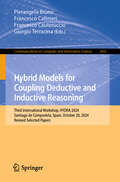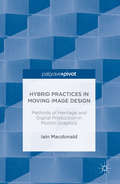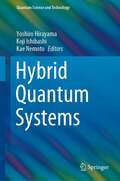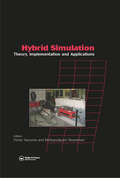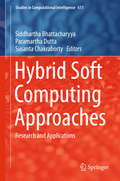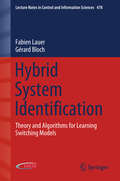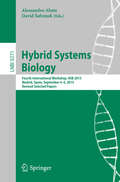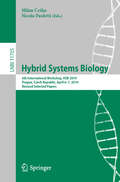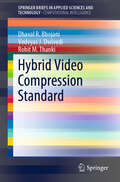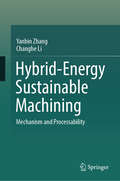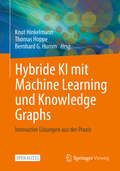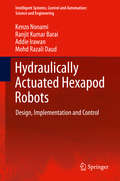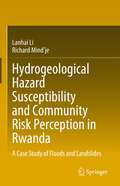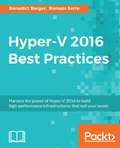- Table View
- List View
Hybrid Models for Coupling Deductive and Inductive Reasoning: Third International Workshop, HYDRA 2024, Santiago de Compostela, Spain, October 20, 2024, Revised Selected Papers (Communications in Computer and Information Science #2492)
by Francesco Calimeri Giorgio Terracina Pierangela Bruno Francesco CauteruccioThis book constitutes the refereed proceedings of the Third International Workshop on Hybrid Models for Coupling Deductive and Inductive Reasoning, HYDRA 2024, held in Santiago de Compostela, Spain, on October 20, 2024. The 6 full papers and 1 invited talk included in this book were carefully reviewed and selected from 7 submissions.The International Workshop on Hybrid Models for Coupling Deductive andInductive Reasoning (HYDRA) was designed as a forum for researchers to explore the exciting possibilities at the intersection of deductive and inductive reasoning.
Hybrid Nanostructures as Solid-State Sensors for IoT
by Arindam Biswas Aniruddha MondalThe book provides an in-depth discussion of various Hybrid Nanostructures as solid-state sensors in the context of the Internet of Things (IoT). It explains the vital role that sensors play in IoT to aid in discovering what possibilities ought to be addressed to make the data more meaningful. The book highlights the applicability of biosensing field effect transistor (FET) technology with a specific emphasis on the progress being made in integrating existing FET technology and nanotechnology, using semiconductor nanowires and organic structures.• Offers in-depth discussion on Hybrid Nanostructures as solid-state sensors• Elaborates upon the fabrication of gas sensors using metal oxide semiconductor nanostructures• Studies biosensors based on metal oxide semiconductor nanostructures• Discusses the suitability of various Hybrid Sensors in solving the problems of the Internet of Things (IoT)• Provides extensive support for the development of Hybrid Nanostructures as solid-state sensorsThe book is meant for researchers and scholars of Computer Science and associated disciplines. It also serves as a valuable reference for graduate students, researchers, seeking to deepen their knowledge and engage with the latest advancements in these Hybrid Nanostructures as solid-state sensors.
Hybrid Optimization: The Ten Years of CPAIOR (Springer Optimization and Its Applications #45)
by Pascal Van Hentenryck Michela MilanoHybrid Optimization focuses on the application of artificial intelligence and operations research techniques to constraint programming for solving combinatorial optimization problems. This book covers the most relevant topics investigated in the last ten years by leading experts in the field, and speculates about future directions for research. This book includes contributions by experts from different but related areas of research including constraint programming, decision theory, operations research, SAT, artificial intelligence, as well as others. These diverse perspectives are actively combined and contrasted in order to evaluate their relative advantages. This volume presents techniques for hybrid modeling, integrated solving strategies including global constraints, decomposition techniques, use of relaxations, and search strategies including tree search local search and metaheuristics. Various applications of the techniques presented as well as supplementary computational tools are also discussed.
Hybrid Play: Crossing Boundaries in Game Design, Players Identities and Play Spaces (Routledge Advances in Game Studies)
by Adriana de Souza e SilvaThis book explores hybrid play as a site of interdisciplinary activity—one that is capable of generating new forms of mobility, communication, subjects, and artistic expression as well as new ways of interacting with and understanding the world. The chapters in this collection explore hybrid making, hybrid subjects, and hybrid spaces, generating interesting conversations about the past, current and future nature of hybrid play. Together, the authors offer important insights into how place and space are co-constructed through play; how, when, and for what reasons people occupy hybrid spaces; and how cultural practices shape elements of play and vice versa. A diverse group of scholars and practitioners provides a rich interdisciplinary perspective, which will be of great interest to those working in the areas of games studies, media studies, communication, gender studies, and media arts.
Hybrid Practices in Moving Image Design
by Iain MacdonaldThis book, written from the perspective of a designer and educator, brings to the attention of media historians, fellow practitioners and students the innovative practices of leading moving image designers. Moving image design, whether viewed as television and movie title sequences, movie visual effects, animating infographics, branding and advertising, or as an art form, is being increasingly recognised as an important dynamic part of contemporary culture. For many practitioners this has been long overdue. Central to these designers' practice is the hybridisation of digital and heritage methods. Macdonald uses interviews with world-leading motion graphic designers, moving image artists and Oscar nominated visual effects supervisors to examine the hybrid moving image, which re-invigorates both heritage practices and the handmade and analogue crafts. Now is the time to ensure that heritage skills do not atrophy, but that their qualities and provenance are understood as potent components with digital practices in new hybrids.
Hybrid Quantum Systems (Quantum Science and Technology)
by Yoshiro Hirayama Koji Ishibashi Kae NemotoThis book presents state-of-the-art research on quantum hybridization, manipulation, and measurement in the context of hybrid quantum systems. It covers a broad range of experimental and theoretical topics relevant to quantum hybridization, manipulation, and measurement technologies, including a magnetic field sensor based on spin qubits in diamond NV centers, coherently coupled superconductor qubits, novel coherent couplings between electron and nuclear spin, photons and phonons, and coherent coupling of atoms and photons. Each topic is concisely described by an expert at the forefront of the field, helping readers quickly catch up on the latest advances in fundamental sciences and technologies of hybrid quantum systems, while also providing an essential overview.
Hybrid Simulation: Theory, Implementation and Applications
by Victor Saouma Mettupulayam SivaselvanHybrid Simulation: Theory, Implementation and Applications deals with a rapidly evolving technology combining computer simulation (typically finite element) and physical laboratory testing of two complementary substructures. It is a multidisciplinary technology which relies heavily on control theory, computer science, numerical techniques and finds applications in aerospace, civil, and mechanical engineering.
Hybrid Soft Computing Approaches
by Siddhartha Bhattacharyya Paramartha Dutta Susanta ChakrabortyThe book provides a platform for dealing with the flaws and failings of the soft computing paradigm through different manifestations. The different chapters highlight the necessity of the hybrid soft computing methodology in general with emphasis on several application perspectives in particular. Typical examples include (a) Study of Economic Load Dispatch by Various Hybrid Optimization Techniques, (b) An Application of Color Magnetic Resonance Brain Image Segmentation by Para Optimus LG Activation Function, (c) Hybrid Rough-PSO Approach in Remote Sensing Imagery Analysis, (d) A Study and Analysis of Hybrid Intelligent Techniques for Breast Cancer Detection using Breast Thermograms, and (e) Hybridization of 2D-3D Images for Human Face Recognition. The elaborate findings of the chapters enhance the exhibition of the hybrid soft computing paradigm in the field of intelligent computing.
Hybrid Soft Computing for Image Segmentation
by Siddhartha Bhattacharyya Paramartha Dutta Sourav De Goran KlepacThis book proposes soft computing techniques for segmenting real-life images in applications such as image processing, image mining, video surveillance, and intelligent transportation systems. The book suggests hybrids deriving from three main approaches: fuzzy systems, primarily used for handling real-life problems that involve uncertainty; artificial neural networks, usually applied for machine cognition, learning, and recognition; and evolutionary computation, mainly used for search, exploration, efficient exploitation of contextual information, and optimization. The contributed chapters discuss both the strengths and the weaknesses of the approaches, and the book will be valuable for researchers and graduate students in the domains of image processing and computational intelligence.
Hybrid Soft Computing for Multilevel Image and Data Segmentation
by Siddhartha Bhattacharyya Paramartha Dutta Susanta Chakraborty Sourav DeThis book explains efficient solutions for segmenting the intensity levels of different types of multilevel images. The authors present hybrid soft computing techniques, which have advantages over conventional soft computing solutions as they incorporate data heterogeneity into the clustering/segmentation procedures. This is a useful introduction and reference for researchers and graduate students of computer science and electronics engineering, particularly in the domains of image processing and computational intelligence.
Hybrid System Identification: Theory and Algorithms for Learning Switching Models (Lecture Notes in Control and Information Sciences #478)
by Fabien Lauer Gérard BlochHybrid System Identification helps readers to build mathematical models of dynamical systems switching between different operating modes, from their experimental observations. It provides an overview of the interaction between system identification, machine learning and pattern recognition fields in explaining and analysing hybrid system identification. It emphasises the optimization and computational complexity issues that lie at the core of the problems considered and sets them aside from standard system identification problems. The book presents practical methods that leverage this complexity, as well as a broad view of state-of-the-art machine learning methods.The authors illustrate the key technical points using examples and figures to help the reader understand the material. The book includes an in-depth discussion and computational analysis of hybrid system identification problems, moving from the basic questions of the definition of hybrid systems and system identification to methods of hybrid system identification and the estimation of switched linear/affine and piecewise affine models. The authors also give an overview of the various applications of hybrid systems, discuss the connections to other fields, and describe more advanced material on recursive, state-space and nonlinear hybrid system identification.Hybrid System Identification includes a detailed exposition of major methods, which allows researchers and practitioners to acquaint themselves rapidly with state-of-the-art tools. The book is also a sound basis for graduate and undergraduate students studying this area of control, as the presentation and form of the book provides the background and coverage necessary for a full understanding of hybrid system identification, whether the reader is initially familiar with system identification related to hybrid systems or not.
Hybrid Systems Biology
by Alessandro Abate David ŠafránekThis book constitutes the thoroughly referred post-workshop proceedings of the 4th International Workshop on Hybrid Systems biology, HSB 2015, held as part of the Madrid Meet 2015 event, in Madrid, Spain in September 2015. The volume presents 13 full papers together with 2 abstracts of invited sessions from 18 submissions. The scope of the HSB workshop is the general area of dynamical models in Biology with an emphasis on hybrid approaches -- by no means restricted to a narrow class of mathematical models -- and taking advantage of techniques developed separately in different areas.
Hybrid Systems Biology: 6th International Workshop, HSB 2019, Prague, Czech Republic, April 6-7, 2019, Revised Selected Papers (Lecture Notes in Computer Science #11705)
by Nicola Paoletti Milan ČeškaThis book constitutes the thoroughly refereed proceedings of the 6th International Workshop on Hybrid Systems Biology, HSB 2019, held in Prague, Czech Republic, in April 2019.The 8 full papers presented in this book together with 1 short paper and 3 invited papers were carefully reviewed and selected from 13 submissions. They cover topics such as: modeling and analysis of metabolic, signaling, and genetic regulatory networks in living cells; models of tissues, organs, physiological models; models and methods coping with incomplete, uncertain and heterogeneous information including learning for biological systems, parametric synthesis and inference; stochastic and hybrid models in biology; hierarchical systems for multi-scale, multi-domain analysis; abstraction, approximation, discretization, and model reduction techniques; modeling, analysis and design for synthetic biology, cyber-biological systems and biomedical studies (e.g. therapies, teleoperation); game-theoretical frameworks and population models in biology (e.g. mixed-effects and Bayesian modeling); biological applications of quantitative and formal analysis techniques (e.g. reachability computation, model checking, abstract interpretation, bifurcation theory, stability and sensitivity analysis); efficient techniques for combined and heterogeneous (stochastic/deterministic, spatial/non-spatial) simulations for biological models; modeling languages and logics for biological systems with related analysis and simulation tools; and control architectures of biological systems including biology-in-the-loop systems and bio-robotics.
Hybrid Threats, Cyberterrorism and Cyberwarfare
by Helge Janicke Ioanna Kantzavelou Leandros Maglaras Mohamed Amine FerragNowadays, in Cyberspace there is a burst of information that everyone has access. However, apart from the advantages the Internet offers, it also hides numerous dangers for both people and nations. Cyberspace has a dark side, including terrorism, bullying, and other types of violence. Cyberwarfare is a kind of virtual war that causes the same destruction that a physical war would also do. A hybrid threat is an umbrella term, encompassing a wide variety of existing adverse circumstances and actions, such as terrorism, migration, piracy, corruption, ethnic conflict etc and is not exclusively a tool of asymmetric or non-state actors, but can be applied by state and non-state actors alike. ‘Cyber-conflict’ and ‘cyber-war’ serve as examples of the use of new technologies within the scope of hybrid threats. Cyber-war basically refers to a sustained computer-based cyber-attack by a state against the IT infrastructure of a target state. On the other hand cyber-security is a major factor that shapes productivity and efficiency of the modern industry in both technical and economic terms. The book discusses and analyses current posture of cyberterrorism, cyberwarfare, and hybrid threats, sector specific cyber-attacks that have the form of cyberterrorism and presents the recent actions that EU, USA and other Nations have taken in order to strengthen their systems against such attacks. There has never been a higher risk of a major catastrophe as a result of the rise in offensive cyber activity, particularly the possibility of cyber-physical strikes against critical services. Recent cyber-attacks against critical infrastructures along with the continuous migration crisis have been the main driving forces that led to the decision to publish this book.
Hybrid Video Compression Standard (SpringerBriefs in Applied Sciences and Technology)
by Rohit M. Thanki Vedvyas J. Dwivedi Dhaval R. BhojaniThe book presents compression techniques for digital video stream, describing their design using various image transforms, such as discrete cosine transform (DCT), discrete wavelet transform (DWT), and singular value decomposition (SVD). It first discusses the basic requirements and applications of video compression techniques. The book then addresses video compression using DCT as well as the hybrid compression technique, designed and implemented using DCT, DWT and SVD, demonstrating the simulation results for both. Lastly, it proposes future research directions in the field.
Hybrid Virtual Teams in Shared Services Organizations: Practices to Overcome the Cooperation Problem (Progress in IS)
by Thomas AfflerbachThis book focuses on virtual teams, which are fraught with cooperation problems. It offers novel insights into how team members experience and overcome these problems by empirically studying hybrid virtual teams in Shared Services Organizations. It firstly enhances the reader’s understanding of contextual challenges relating to cooperation and shows how members of such teams experience faultlines through distance, disconnection through reliance on communication technology and discontinuity through temporality of team composition. Secondly, it explores how they use 22 practices to overcome the cooperation problem, which can be categorized as strategies of identity constructing, trusting and virtual peer monitoring. Lastly, the study analyzes the role of technology, demonstrating that state-of-the-art media can facilitate, but not ensure the use of these strategies and practices. As such, the book has implications for both researchers and practitioners.
Hybrid and Advanced Compression Techniques for Medical Images
by Rohit M. Thanki Ashish KothariThis book introduces advanced and hybrid compression techniques specifically used for medical images. The book discusses conventional compression and compressive sensing (CS) theory based approaches that are designed and implemented using various image transforms, such as: Discrete Fourier Transform (DFT), Discrete Cosine Transform (DCT), Discrete Wavelet Transform (DWT), and Singular Value Decomposition (SVD) and greedy based recovery algorithm. The authors show how these techniques provide simulation results of various compression techniques for different types of medical images, such as MRI, CT, US, and x-ray images. Future research directions are provided for medical imaging science. The book will be a welcomed reference for engineers, clinicians, and research students working with medical image compression in the biomedical imaging field. Covers various algorithms for data compression and medical image compression;Provides simulation results of compression algorithms for different types of medical images;Provides study of compressive sensing theory for compression of medical images.
Hybrid-Energy Sustainable Machining: Mechanism and Processability
by Changhe Li Yanbin ZhangThis book explores the machinability mechanism of hard-to-machining materials under hybrid energy field, with a particular emphasis on the development and modification of green lubricants, the integration of multi-energy field assistance, and the intelligent machining equipment. It offers a comprehensive overview of cleaner precision manufacturing techniques, multi-energy assisted processing applications, and sustainable manufacturing practices, presenting innovative strategies for energy conservation, emission reduction, and the advancement of an eco-friendly society. By enhancing the sustainable use of bio-lubricants in intelligent machining and utilizing multi-energy field assistance to improve grinding and turning performance, this book provides a green, clean, and precise machining approach that prioritizes environmental protection, resource efficiency, and energy sustainability, while addressing the compatibility challenges between intelligent machining systems and clean energy applications.
Hybride KI mit Machine Learning und Knowledge Graphs: Innovative Lösungen aus der Praxis
by Thomas Hoppe Knut Hinkelmann Bernhard G. HummSeit den 2010er Jahren hat die Künstliche Intelligenz (KI) durch Erfolge im Machine Learning (ML) einen enormen Schub erfahren. Einerseits durch die stark angewachsene Menge verfügbarer digitaler Daten und andererseits durch Innovationen im Bereich der Künstlichen Neuronalen Netze und des Deep Learning (DL). Wissensbasierte KI umfasst neben traditionellen Expertensystemen und Regelsystemen auch die Technologien und Standards, welche im Rahmen der Semantic Web Initiative seit den 1990er Jahren entwickelt wurden. Sie ermöglichten unter anderem die Entwicklung umfangreicher Knowledge Graphs (Wissensnetze). Hybride KI Ansätze kombinieren Machine Learning und wissensbasierte KI. Da sie als erfolgversprechend gelten, werden sie seit Jahren erforscht. Dieser Sammelband zeigt, wie innovative hybride KI-Verfahren bereits heute erfolgreich in der Praxis eingesetzt werden. Dies ist ein Open Access-Buch.
Hydraulically Actuated Hexapod Robots
by Kenzo Nonami Ranjit Kumar Barai Addie Irawan Mohd Razali DaudLegged robots are a promising locomotion system, capable of performing tasks that conventional vehicles cannot. Even more exciting is the fact that this is a rapidly developing field of study for researchers from a variety of disciplines. However, only a few books have been published on the subject of multi-legged robots. The main objective of this book is to describe some of the major control issues concerning walking robots that the authors have faced over the past 10 years. A second objective is to focus especially on very large hydraulically driven hexapod robot locomotion weighing more than 2,000 kg, making this the first specialized book on this topic. The 10 chapters of the book touch on diverse relevant topics such as design aspects, implementation issues, modeling for control, navigation and control, force and impedance control-based walking, fully autonomous walking, walking and working tasks of hexapod robots, and the future of walking robots. The construction machines of the future will very likely resemble hydraulically driven hexapod robots like the ones described in this book - no longer science fiction but now a reality.
Hydrogeological Hazard Susceptibility and Community Risk Perception in Rwanda: A Case Study of Floods and Landslides
by Lanhai Li Richard Mind’jeThis book employs qualitative and quantitative methods to assess and scrutinize the impacts of climatic, topographic, land use, hydrologic and geologic factors on the hydrogeological disasters particularly flood and landslide in Rwanda. The hydrogeological hazard susceptibility and its spatial distribution is also mapped by integrating geospatial techniques and mathematical modeling approach through remote sensing and Geographical Information System (GIS). On the other hand, questionnaires and interview are used to evaluate the community's perception on the risk of hazards. The results unveiled different zones most susceptible to the incidence of both hazards as well as their main contributing factors. Furthermore, the results revealed that the government is perceived as responsible for all mitigation measures instead of being a shared responsibility, a perception that may also contribute to the increase in susceptibility. Therefore, it is necessary to deliver the extent of disaster-related courses and trainings in both schools (from primary to tertiary level) and local community members, which helps improving the public's awareness, understanding and ability by providing a new perspective toward disaster prevention and reduction. The book provides a reference for interested readers to understand the natural and human geography of Rwanda, the distribution of hydrogeological disasters, and the policy-making of disaster prevention and reduction.
Hydrological Data Driven Modelling
by Jimson Mathew Renji RemesanThis book explores a new realm in data-based modeling with applications to hydrology. Pursuing a case study approach, it presents a rigorous evaluation of state-of-the-art input selection methods on the basis of detailed and comprehensive experimentation and comparative studies that employ emerging hybrid techniques for modeling and analysis. Advanced computing offers a range of new options for hydrologic modeling with the help of mathematical and data-based approaches like wavelets, neural networks, fuzzy logic, and support vector machines. Recently machine learning/artificial intelligence techniques have come to be used for time series modeling. However, though initial studies have shown this approach to be effective, there are still concerns about their accuracy and ability to make predictions on a selected input space.
Hydrology in a Changing World: Challenges in Modeling (Springer Water)
by Shailesh Kumar Singh C. T. DhanyaThis book offers a comprehensive overview of the challenges in hydrological modeling. Hydrology, on both a local and global scale, has undergone dramatic changes, largely due to variations in climate, population growth and the associated land-use and land-cover changes. Written by experts in the field, the book provides decision-makers with a better understanding of the science, impacts, and consequences of these climate and land-use changes on hydrology. Further, offering insights into how the changing behavior of hydrological processes, related uncertainties and their evolution affect the modeling process, it is of interest for all researchers and practitioners using hydrological modeling.
Hyper-Digital Marketing: Six Pillars of Strategic Brand Marketing in an AI-Powered World
by Vanitha SwaminathanThe rapid changes in technology and the rise of AI have heralded the introduction of a new era, which we refer to as the era of hyper-digitalization. This shift has significant impacts on how organizations and enterprises carry out critical functions across various areas, including marketing, information technology, human resources, and others. We are witnessing the transformation of the marketing function, with many traditional roles of marketers being replaced by new roles that depend heavily on cross-functional coordination with multiple areas. These changes could be far-reaching and have already dramatically impacted how to organize many tasks within organizations. Against this backdrop, this book offers modern marketers and technologists a guide on navigating the many changes occurring in organizations. Any senior executive can leverage many of the concepts presented in this book and be able to handle the sweeping changes taking place in the age of AI. This book introduces a new framework with six pillars of modern marketing strategy in the age of hyper-digitalization – purpose, phygital experiences, platform, participation, personalization, and partnerships. Each pillar has its own chapter, which provides specific guidance for managers on how to implement it. The chapters also demonstrate how each pillar can influence key outcomes like attention and engagement. In the context of hyper-digitalization and AI, the six-pillar framework will help managers navigate current developments and implement changes that any enterprise is faced with. It will offer senior marketing strategists and students a framework for strategic thinking that prepares them for the workplace of tomorrow. The framework is supported by numerous case studies and examples (from both the United States and other parts of the world) that demonstrate how these concepts are applied in real-world situations. The book incorporates insights from scholarly research on these topics to provide evidence-based guidance for managers and executives.
Hyper-V 2016 Best Practices
by Benedict Berger Romain SerreHarness the power of Hyper-V 2016 to build high-performance infrastructures that suit your needs About This Book * Design and build a reliable and efficient Hyper-V infrastructure. * Fine-tune your Hyper-V performance by adopting network and storage best practices. * Manage, monitor, and protect your workloads with System Center and Microsoft Azure. Who This Book Is For If you are working with Hyper-V and want to optimize its performance and effectiveness, this book is for you. This book will help you close the gap between the Hyper-V lab and production environments. What You Will Learn * Automate and accelerate the deployment of Hyper-V host and nano servers * Create high availability solutions using failover clustering * Design redundant solutions with Hyper-V Replica * Protect your workloads by making a backup or learning disaster recovery * Use the best practices of network and storage * Master the performance and scalability of storage virtualization * Migrate your existing virtualization workloads to Hyper-V2016 * Manage your Hyper-V stack with System Center and Azure * Bridge the gap between the Hyper-V lab and production environment In Detail Hyper-V Server and Windows Server 2016 with Hyper-V provide best-in-class virtualization capabilities. Hyper-V is a Windows-based, very cost-effective virtualization solution with easy-to-use and well-known administrative consoles. This book will assist you in designing, implementing, and managing highly effective and highly available Hyper-V infrastructures. With an example-oriented approach, this book covers all the different tips and suggestions to configure Hyper-V and provides readers with real-world proven solutions. This book begins by deploying single clusters of High Availability Hyper-V systems including the new Nano Server. This is followed by steps to configure the Hyper-V infrastructure components such as storage and network. It also touches on necessary processes such as backup and disaster recovery for optimal configuration. The book does not only show you what to do and how to plan the different scenarios, but it also provides in-depth configuration options. These scalable and automated configurations are then optimized via performance tuning and central management ensuring your applications are always the best they can be. Style and approach This book covers Hyper-V best practices in a step-by-step manner with clear and concise examples.
